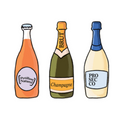

Decode the info and unlock the treasures within!
It’s a familiar scene for most of us: standing in the wine store, looking blankly at the labels of the wine bottles which glare down at us from the shelves. What do most of us do?
We try desperately to decode the information on the front, before caving in and reaching for a bottle festooned with a pretty picture, or one which features a familiar grape variety in big curly letters.
This is a pretty lame way to choose a wine, and although it might lead to us discovering a new favourite, it’s more likely to leave us feeling a bit lost and uninformed, especially when we’re trying to choose between two similar bottles.
But it's totally reasonable to be honest - wine labels can be tricky, confusing things - especially when they give very little real information away.
This is especially true when it comes to the Old World wine-producing countries - wine labels from the best regions of Italy, France and Spain often don’t tell you anything about the grapes used in their blends, or the methods used to produce them.
Indeed, many of the wines from these countries have labels which confuse even experienced wine drinkers, as if they expect us to understand the wine characteristics of every chateau or appellation. There's complex reasoning and historical precedent behind it - countries like the aforementioned European wine centres are awash with old wine laws, traditions and regulations which must be followed to the letter, in order to guarantee their continuing lofty reputation. Understanding how the labels on these bottles work is actually a way of understanding something about the wine laws of these lands. Hopefully, with a little bit of inside knowledge, we can begin selecting our wines a bit more effectively.
The essentials--red
There are plenty of clues on a wine label which can help point you in the right direction when figuring out what the wine is.
Lots of wine companies nowadays are keen to give their wines names which give away some information about their flavour and character - it’s a good idea to do this if you’re trying to attract a new audience who are perhaps a little cautious when it comes to drinking wine.
As such, if you see a bottle with a name like ‘Flinty White’ or ‘Peach Blush’ etc, you can probably make a sensible guess as to the main characteristics of that wine. Easy. The problem can be that it doesn't tell you the whole story - ie is the wine rich or heavy, is it dry or sweet etc. You often need a few more clues to get the whole picture. Learn more about how to know if a wine is sweet or not if it's not mentioned on the label here.
Many wineries around the world label their wines simply with the name of the principal grape varietal. It’s very common indeed to see a wine called - for example - Good Pair Days Winery: 2018 Shiraz. This is a classier option, and gives you a fairly clear idea of what to expect without being either patronising or pretentious.
Countries, regions, villages and appellations--aromatic
There will almost always be some information about the region and country the wine came from on the bottle. This is actually one part of the wine label of Old World wines that can give us some indication of its quality (although this is not a foolproof test by any means). It all comes down to how specific - and small - the listed region is.
To give an example: let’s say you’re looking for a nice bottle of French wine to take to a dinner party. You’re in the wine shop, and you see on your wine label that the region is listed as ‘France’.
Now, that’s a pretty non-specific label, and we can tell from this that the wine has not been deemed to be of a high enough quality to represent any specific region, or it hasn’t followed the rules of a region to be permitted to bear one on the label.
Other wines might have smaller - but still very general - regions on their label. To use France as an example again, these would include ‘Bordeaux’ ‘Burgundy’ or ‘Rhone’, etc. We could expect these wines to be of a higher quality, as they are tying themselves to a particular region and therefore must be representative of those geographic areas.
If you want to seek out more refined examples, look out for those wines which list specific appellations, villages, chateaus etc - these will be subject to more vigorous quality control, as they are representative of very small areas. Think of the classic fine French wines: Chateauneuf du Pape, St. Emilion, Sancerre… all bearing the names of very specific places.
It’s in the blend--racy
Knowing which grapes your wine is made from can be important, especially if you’re planning to pair your wine with food. However, it isn’t always easy to figure this information out from the label.
Most bottles you’ll come across will list the grape varietal the wine is made from, but again, in the Old World European countries we’ve already mentioned, there is often no mention of grape varietals at all! This is usually because the wine is made from a blend of grapes, and the nature of this blend is - again - dictated by the laws of a particular region.
Bordeaux red wines, for example, need to be made from a blend of Cabernet Sauvignon, Merlot and Cabernet Franc (often with small quantities of other red varietals in the mix) but it’s unlikely any of these will be listed on the label.
There are many reasons why wineries are obligated to use these blends - it’s partly again to preserve tradition, to uphold levels of quality and reliability, and also to protect the vineyards - many of which have been in continuous use for centuries.
Getting to know the blends of certain wine regions and appellations can be hard work, but very rewarding if that’s your thing. Thankfully, we now have access to the internet and various wine apps that can help you out - we no longer have to memorise countless combinations of vine species and Italian villages (although it would be quite cool to be able to do that) in order to know what we’re drinking.
It’s also worth bearing in mind that a lot of the stuff you see on wine labels really is more or less meaningless nonsense. A classic example is the term ‘Reserve’ - there are no official rules in many countries (Australia included) that dictate who can label their wine a ‘reserve wine’, whatever that actually means.
It is generally used as a way to make an average wine appear more interesting. Look out instead for ‘Estate’ wines - these are wines which are made from grapes that have been cultivated, grown, picked, processed and bottled on a single estate by a single winery, and while this isn’t a 100% watertight guarantee of quality, it does suggest that the winery is willing to put their reputation on the line by claiming they are solely responsible for the produce.
Wine labels can be tricky, confusing things, so we hope you have learned a thing or two on how to better understand wine laws and how to be a well-informed wine shopper, in general.
Happy hunting!
About the Author
Banjo Harris Plane is the three-time winner Sommelier of the Year Australia and a certified advanced Sommelier through the Court of Master Sommeliers. He first cut his teeth in the wine industry working as a sommelier in Australia's best restaurants, before starting multiple businesses in the space of a few years... these included two restaurants, a wine import business and co-founding Good Pair Days!
Do you know your wine personality? If your answer is no, take our quiz to find out which wines to pick up next and build your box!
Build my box





